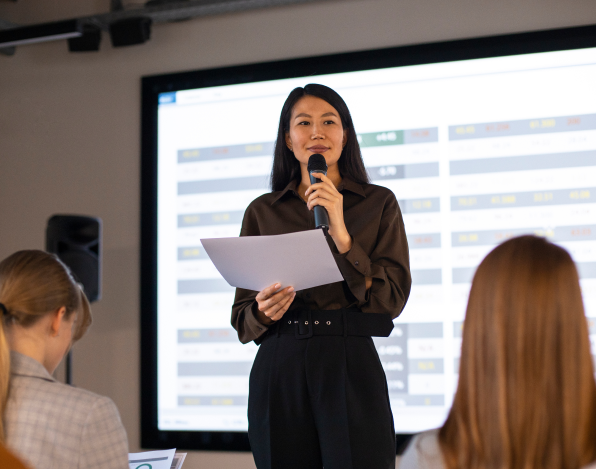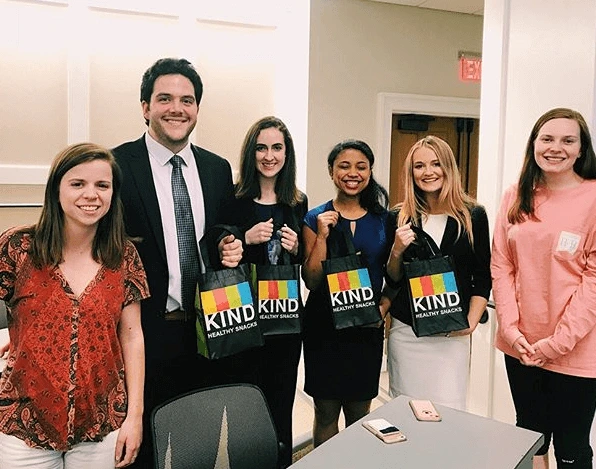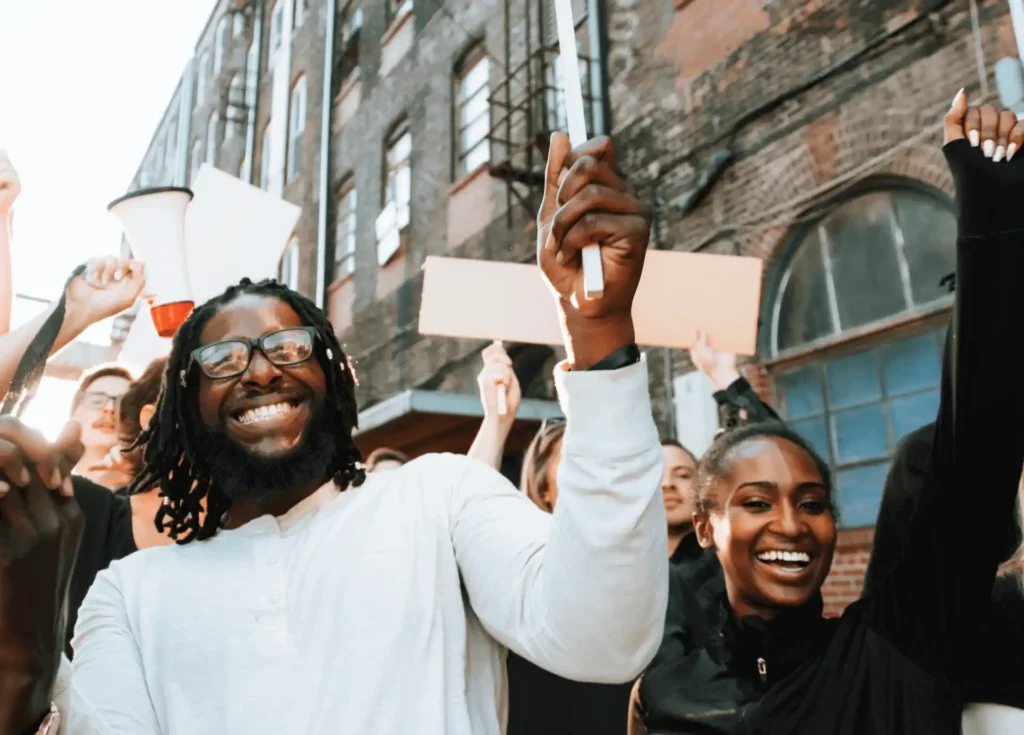By Royce Johnson
AMA New York Volunteer
Building your personal brand is not for the faint of heart. Emily Miethner, Founder and CEO of FindSpark, hosted a workshop for AMA New York to discuss what separates a good online presence from an amazing one. Your professional brand is how you see yourself and how others see you in relation to your work. Emily wants you to engage more online and share what you’re proud of to successfully land your next role. FindSpark is an online and offline community dedicated to setting up every young professional for career success and connecting employers to top, diverse early career talent. Emily told us how to use your online network to land interviews, how to maintain your connections in the digital era, and how to present yourself online.
Transcript:
00:00 I would like to encourage everybody to think of how they can be a positive voice in all that is going on. Excited to share more so that we can all become leaders to creating a more equitable workforce. It’s a big part of my work that I do at FindSpark, and I think everybody can contribute. I also recommend turning off other devices, closing out other windows and just grabbing a pen and paper if you haven’t already, so you’re fully here and invested in what’s going on. Sharing on social media. This is a great opportunity to post on social media about what you are doing. Of course there are some great hashtags: You can tag AMA and also COVID, just recognizing that we are in the same boat. That it’s okay to be disappointed. Things are changing so quickly. No one has all the answers, but I like to take a positive approach and I think that everything that I would teach in my workshops before COVID are just even more important now, because the job market is about to get so competitive. It’s going to be more important than ever to build and maintain a strong network and support system for yourself and make sure that you’re putting yourself out there so that people can help you more easily.
01:21 All right so, what should you be thinking about when it comes to your online presence? Does your online presence best reflect your past, your present, and what you want to do in the future? Things that you need to keep in mind are: Are people aware of your goals? Your relevant experience? So for instance, those of you who might be transitioning to a new career path should reflect if the way you’re positioning your experience helps present you for what you want to do in the future. Making sure you’re actively sharing, not just sort of the day-to-day, but the accomplishments and the results and the things that you’re really proud of. Of course, what makes you different? Part of that are those accomplishments, but a big part of that is also what you care about, and what makes you different and unique as a person.
02:17 This goes for your networking, a pitch, and your online application. Keeping these four bullets in mind are really important. What can your online presence do for you? That will be the focus of my presentation. So you can become discoverable, right? You want your profiles to get found by people who are looking for your talent, looking for your skills. You want to use it to grow your network. Everyone is in the same boat now and will be for a while with there being limited in person face-to- face interactions. This is a good time to get out of your comfort zone and become more open to networking with people who you haven’t met prior and are just meeting online. Then of course, being able to use your personal brand in these profiles to actually maintain your networks, or to stay in touch with people on a wide scale, once you bring them into that network.
03:14 The very first place that you want to start when you’re thinking about your online presence is your bio. Your headline, your social media bio whether it’s on Instagram, or LinkedIn, or Twitter. I’m just curious, I would love to see in the chat, everybody type which platforms they’re interested in using professionally. I’m sure everybody’s going to type in LinkedIn, but I’m curious if people have other platforms they’re interested in exploring, and how they can use them in a more professional way, or professional and personal. Instagram and Twitter, of course, other two big ones, especially within the marketing world. Facebook is a place that you can use as a more professional tool. Actually, I don’t talk too much about Facebook here, but what I would recommend for Facebook is that everybody look for some professional Facebook groups. I believe that Facebook groups are the most useful part of Facebook right now, and may be one of the only super useful parts of it. I think most people are still using Facebook mainly personally, but there are these groups and you can really search anything…women in advertising you know, lesbians in tech, there’s all these different identity groups or groups that are just based around industries or locations. Do a quick search and look for some groups you can join professionally to network and find jobs. What are people learning about you just from your bio? All right, so a little formula I like to use, it’s easy to remember is: What you’re doing, what you’ve done, and something fun. Easy to remember because it rhymes, right? What are you currently doing? What are some of the major things you’ve done in the past? Share something a bit fun about you?
05:03 What are your interests? What are you passionate about specifically within you? What are you trying to do better? One of the most important things you can do right now is make it really easy for people to see what you are looking for next. One of the basic ways you can do that for instance, is with your LinkedIn headline. You might want to consider explicitly stating that you are seeking your next opportunity, that you are open for freelance work. That is really helpful for people to know right off the bat because that LinkedIn headline is the first thing that people are going to see when they see your profile on a search or when you go to connect with them on LinkedIn. Your headline is really important. Most people for their headline, all they put is their current job. That is a mistake. You can actually fit a lot into the character limitations of a headline. Consider that same formula of what you’re doing, what you’ve done, and something fun. Also a fairly new feature of LinkedIn is that you can specifically on the backend of your settings, say what sort of opportunities that you’re open for. You can see here, I highlighted it in red. That’s something that you can use to determine who can see what you’re open for. You can make it a privacy setting where only recruiters or people with LinkedIn Recruiter will be able to see that you’re open for opportunities. For instance, if you’re trying to leave your current employer, LinkedIn will actually make it so your current employers’ recruiters can’t see that you’re saying you’re open for opportunities, but you want to be really clear, because so many people are going to be on the job market. The more specific you can be about what you’re looking for, the better. It’s a little scary to do that because you might feel like you’re limiting yourself from other opportunities, but again, because it’s going to be so competitive, you really want to hone in on what you’re going to be the best fit for and what type of opportunity you want. Other things to include? Things like leadership. Leadership is a great differentiator and there are all different types of leadership ways that that can kind of play out. Are you including that in your LinkedIn, in the content that you’re posting? So for instance, I’m sure many of you are involved in leadership in AMA. Where is that throughout your LinkedIn profile? There are actually sections for things like this, but you can also include them in more prominent places like your summary. Also volunteerism is a great thing to talk about. Again, there are specific sections on LinkedIn where you can talk about your volunteer activities and you can just list places where you volunteer, but you can also get into more detail about what type of impact you’ve had in a volunteer role. In the same way, you can put more details about the impact you’ve had at a paid, you know, official role.
08:04 Also, LinkedIn is a great place to talk about things that you’ve brought to life on your own accord, outside projects. So for instance, this person does sales planning at Disney, but they also put together a benefit concert, and they talked about how much money they raised and how many pounds of nonperishable food that they raised. This is a really cool thing to do to highlight, and if you’re in between work it’s a great example if you can create some sort of opportunity or program or do something useful for other people during this time that will show off what you’re passionate about, but also show that you’re staying busy or working on your skills. You can put projects on your LinkedIn, as you can see this person and actually tag other people. You can tag others who you’ve worked on that particular project with, which is a nice way to shout out your colleagues and people you’ve worked with. Your online presence is a place where you want to talk about the things that you are most proud of. You can get creative with how you’re showing these things. It can be things like rich media on your LinkedIn. This is actually a pinned tweet. On Twitter, of course as you post more and more of these tweets, your tweets will get pushed down into your timeline, but you can have a pinned tweet as well. That’s a great place on Twitter to put something that you’re especially proud of. This person talked about being nominated for an award. The great thing about Twitter is that you can also tag other people. Not only is he talking about himself, but he is tagging other people who worked with him on this programming and were a part of receiving this award. Pinned tweets and posting content when you have done something fantastic is of course, something that you want to do. Also talking about side projects, businesses, things that you’ve started from scratch. These are excellent things to include on your online presence, because they show that you’re going beyond the normal nine-to-five. Or again, if you’re in between work, this is a moment to see if you can get some clients, whether that’s family and friends, helping out other people or creating projects from scratch for yourself, anything from, you know, launching an Etsy account and selling creative work, for instance. Something that I’ve done throughout this period of COVID is my aunt and uncle own a very small theater up in Vermont that is pretty much continuously struggling and had to shut down because of COVID. Over the last couple of months, I helped my aunt and uncle launch a Patreon account for their theater to raise money to keep the theater going. Can you find a small business or a family member who is struggling and use your marketing skills to help them during this time? When you do something like that, it’s absolutely something you should include and talk about. It doesn’t have to be things that you’re only officially getting paid for. Entrepreneurial projects are excellent to include. Going beyond just what are you putting on your profile? Of course, that’s all really important, like the sort of stagnant content or the static content that should not be stagnant. You want to be frequently updating things. What I like to do is really simple; I have a monthly calendar alert on my Google calendar, because I don’t know about you all, but I live by my Google calendar that just says, “Update social media profiles.”
11:52 Once a month I get a G-Cal alert that just reminds me to think about, “Hey, is there something new I can add to my profile?” “Do I want to update some content?” “Do I have a new accomplishment?” I would encourage you in whatever way you run your to-do list, to put some sort of reminder like that so that your profiles don’t become so outdated that updating them can become overwhelming. These are constantly things you want to be updating in a sort of constant, consistent way. What type of posts should you be creating to build your online presence? Number one is being helpful. I think being helpful is the best way to network. Sharing resources that you find helpful are most likely going to be helpful for your network. When you find these helpful things, articles or videos or resources, take a moment to stop and pause and post about them and share them. Share what you are already consuming.
12:55 I’m sure you’re already reading news and blogs and even other people’s posts. Just resharing and sharing, taking a minute to share that content again, integrating it into your sort of daily or weekly flow. Giving people shout outs is also huge. What is one of the first things that you all do when you sign on to a social media channel? Just curious, if anyone wants to share in the chat the first thing you do when you open your app or you open up LinkedIn on your screen, what would you say is the first thing you click? First thing you do? Anyone? Notifications, yes! Okay, messages, notifications. Great. Everyone wants to see that little red dot that says someone has acknowledged my existence. We can’t deny that red dot. You give other people shout outs.
13:56 When you’re posting, always think about, “Is there someone I can tag in this post?” because they wrote it or they’d be interested in it, or “I found it because of them”, or you’re just thanking someone for doing a good job or giving someone kudos. It’s an incredible thing to work into your schedule, to build up your network and create some social media karma. Also, posting updates about your work and experiences with new skills that you’re learning, projects that you’re working on and that sort of thing.
14:33 Here’s an example: When you get hired, talking about the people who helped you throughout that hiring process is always a really nice thing to do. On the opposite side of posting about when you are leaving a job as well, giving people shout outs. I’m sure many of you have had your LinkedIn filled up with people talking about the fact that they’ve lost their job because of COVID. If it’s something that you feel uncomfortable doing, that of course is totally normal, but if it helps you feel like it’s, it’s more normal…I mean, so many people are doing it because so many people are going through it. I hope that the long term effect of COVID-19, is that people feel like they could be more vulnerable and ask for help and support during rough times. Those types of posts, also finding opportunities, hashtags, things that are happening on the Internet already and becoming a part of them.
15:34 For instance, there is a thing called Portfolio Day. It is a hashtag that is active on Instagram and Twitter. I discovered it because I teach at School of Visual Arts with a lot of animators, designers, and creatives. It happens the second Tuesday, every other month or something like that. Basically it’s an opportunity for people to share their work. It’s something on that day, when it’s happening, a lot of people are doing it. It’s a great way to get discovered and to discover other people. Think about your industry and pay attention to these sort of online hashtags or things that are happening and insert yourself into those conversations.
16:19 I really liked this post as an example. This is a member of the FindSpark community who at the point when I screenshot was looking for a full time job as a recent graduate. She actually is talking about how she’s very uncomfortable talking about herself with attention online. She calls herself a shy extrovert here, that in an in-person situation, she’s more comfortable being a leader, but online it makes her a little uncomfortable. She’s basically saying how she’s recognizing that and pushing herself outside of her comfort zone to share some of the work that she’s doing. Here she did it as a LinkedIn article. Creating a LinkedIn article, which is essentially like a blog post, is a great way to share more content, more in depth content with your network on LinkedIn.
17:14 It’s different from a post on your feed, a post on your feed, there’s a character limit. If you’re creating an article on LinkedIn, there’s much more room there and it also is a little bit more prominent on your profile. Everybody is in this situation where so much networking is happening online. Even if you’re in a city where you feel like, phase one, two or three, whatever it is with COVID is going to happen sooner than others, they’re still going to be limited face-to-face networking. Now is a time to explore ways that you’ll feel more comfortable putting content out there and talking about yourself and talking online, ‘cause everybody’s in the same boat.
18:09 Now, Instagram is a really great place to be, a platform to use if you’re into the creative world. Creative is broad. Everything from marketing to advertising to design. Maybe you want to be doing marketing in an industry. That’s a more creative place. I really love Instagram Stories for instance, as a place to shout out other people as mentioned, I think. You know, giving shout outs to other people in your network is a great way to build a strong brand. A brand that says, “Hey, these are other people who I believe in or who I know”. These are some examples here. For instance, this is a story highlight. This is one of my students. She’s incredible. She did a story highlight where she just shouted out all of her, not all, but a bunch of her peers, her students who also finished their thesis projects.
19:00 As students you will have these big projects, “Can you shout out these people?” She did this whole story where you can see there are about 10 different posts and she made that a story highlight on her Instagram. That always stays at the top. She’s got a highlight that says “My peers”, and even just having a story highlight that says, “I’m shouting out my peers”, it’s nice. It says something about you. Instagram Stories and Twitter are also great ways to post when you’re at virtual events and in person events as well. This next screenshot here is an example. FindSpark hosts virtual events as well. Theresa was live Instagramming her favorite tips and tagging FindSpark. Tagging myself, tagging the speakers if they had an Instagram.
19:56 Even though we’re doing these virtual events, you can still create posts from those events and shout out the speakers. I think that’s a great way to network. It seems a little self-indulgent, because I would say as practice you could create a post saying, “Oh, I enjoyed the AMA event today with Emily Miethner,” and you can tag me on LinkedIn, you can tag me on Twitter or Instagram. My handle is down there. I will a hundred percent repost you, or like you or like your posts, but doing these posts about events is a great way to network as well. Personal websites are a great way to really own your story and what you want to do. If you are out of work, now is a great time to build a personal website.
20:49 It does not have to be complicated, but it’s a place that you can own. What you’ve done in the past, what you want to do in the future, and the work that is most relevant to that. Are there a lot of free or inexpensive platforms? I would highly recommend investing in a custom URL — that is, your name.com or something like that. We have a lot of resources on FindSpark about creating an online portfolio if you’re interested in that and thinking about your brand consistently. Does your resume have elements that match your website that can also be seen on your LinkedIn? That can be anything from colors to an icon, to the words that you use to describe yourself. One thing I challenge you to think about before the end of the day, is what are three main key words about you, your skills, and the work that you want to do, that you think are the most important words for people to know about you. Make sure those words are prominent on any social media platform where you have a profile,, on your resume, and on your website. Words, colors, graphic elements, these are all things that play a part of your personal brand. Connecting with people in different ways, through different platforms. This is a long-term game. I’ve shared a lot very quickly and we’re going to jump into Q&A soon, but just doing this stuff, consistently experimenting and figuring out what you’re comfortable with. Of course, what you enjoy. You might not enjoy certain platforms and you might enjoy others. Focus on figuring out what you actually enjoy and put your energy there. Do not feel like you have to be on every platform all the time, and it’s not possible for anyone. When you’re thinking about who to reach out to, I recommend this short list: Recruiters, people you admire, speakers, and people who are active. There’s so many people out there, but this list of folks are going to be more likely to respond to you. Instagram is again, also a great place to connect with people and find people if you’re not using a platform already.
23:07 Of course, think of networking as learning. If you’re especially interested in transitioning and doing your research, talking to people is so important right now because of how COVID has disrupted so many businesses and industries. It’s really important to stay up to date with what’s going on. The best way you can do that is by networking and connecting with other people. When you’re doing that outreach, I’m not sure if anyone saw this back in the day, but customizing that outreach is so important. You should not be able to send the same message to anyone, because it should always be specific to that person you’re reaching out to. That’s going to be what gets you the best responses and always saying, thank you is a great idea. Whether or not you feel like this person you’ve connected with say through an event like this is relevant to you, or could be useful, just say, “Hey, it was great to connect at this thing, right?”
24:04 Especially on LinkedIn, that message will stay there in that inbox. If you ever connect in the future, they’ll remember how you connected. This is my general follow up strategy list. I will say that it is more important than ever to be patient, probably be more patient, sort of expand this timeline but to still be persistent because of COVID. Don’t think that COVID means that you should not reach out to people. You should still look to connect with folks during this time, but you have to be even more patient and persistent than normal, because so many people have so much going on right now…more than we would ever know. Here are just some other ways to stay in touch with recruiters. This goes for everybody once you connect with people (this is taken from the FindSpark Instagram account, which I highly recommend following, we post a lot of great useful tips like this).
25:07 I would say embrace being a leader and know that yes, there is some pressure to putting yourself out there more. It’s going to come with judgment and that’s okay. Just being okay with being judged and knowing that, by posting what you want to and it feels right to you. That’s going to attract a network for yourself that you can really enjoy, be supportive, and support them back. I want to close with just four key keywords that I think are really important before Q&A…That everyone be extremely empathetic towards each other, more so than ever. That now is a time to be creative with how we’re creating work, how we’re getting work, and how we’re thinking about work. Being resilient and flexible right now is also incredibly important because of the time that we’re living in.
26:01 I am all about action items and I’m allowed to give homework, ‘cause I’m a professor. This is a good slide to screenshot. It is really important to create actionable goals for yourself. Put time limits on those goals, put numbers next to those goals, because just saying that you want to build a better online presence; it’s very overwhelming. How can you break down big goals into little steps? I would love to hear in the chat, any little steps that you all plan to take because of this. Again, these are just examples. They’re going to be different for everyone. I know I’ve been seeing some great questions in the chat so I’m going to start with those, but I’m also going to pull up the participant list for people who want to ask questions with their audio and really quick, if you enjoyed the presentation so far. I know I’m going to share a lot of other useful stuff in the chat. I would love it if everyone could just take a minute right now to follow FindSpark on Instagram.
27:07 That would be a great way to give me thanks. If you enjoyed the presentation again, we share a lot of really useful stuff there that’s relevant for everyone, no matter where you are in your career. We’re just @FindSpark. I don’t care if you follow me on my personal account, but @FindSpark on Instagram, I would really appreciate that. You can also sign up for FindSpark for free at FindSpark.com. Okay, we have our first sample goal: Become more active with my posts on LinkedIn and check out Twitter and Instagram. Anna, I would encourage you to be even more specific. What is more active on LinkedIn for you? Does that mean posting once a week, one to two times a week? Get even more specific than that and have some numbers so you can set some real goals once a week.
27:55 Perfect. All right, posting once a week is an excellent goal. I’m going to jump back to a few of the questions in the chat, but if you want to ask a question over audio, you can raise your hand. There’s a little ‘raise your hand’ button and I’ll call on you as well. I saw someone ask about ATS systems. Okay, yes, someone asked, “Does having more creative resumes potentially hurt you when you’re applying through the applicant tracking system that scans resumes?” I would recommend not doing anything too crazy design-wise with your resume when you’re submitting it online through an official portal, and definitely make sure you’re submitting it in the format that they ask for, Doc X or PDF, right? Make sure that you send your resume first to other people to check that there’s no wonkiness, but then if you want to have a more creative resume, that would be good to use. For instance, if you’re emailing it to people or sharing it with people when you’re at a networking event, even digitally sending it via message, but I would keep your official resume that you submit online a little more simple to avoid potential formatting issues.
29:24 All right, let’s see. Here’s a question. A current college student, you love having a personal and private Instagram, would you recommend creating a new public one for professional use? If you really love having that fun, private, personal Instagram, keep it going. Depending on your industry, it is something you might want to consider in terms of creating a professional one. You don’t have to use that one all the time. Instagram does make it easy to have multiple Instagram accounts all on your phones. You don’t have to log in and out of your personal and private one. For instance, if you’re in a more creative industry it could be a good idea. You can post things that you’re working on, screenshots of things. You can get creative with it. For instance, a lot of my students at SVA create an Instagram for their thesis project.
30:20 Maybe you have a certain project, you want to use Instagram as a place to have that project. Maybe you want to sort of just do it as an experiment and it’s something fun and creative. For instance, I know someone who does marketing, but they have an Instagram account for their calligraphy and it’s just all their calligraphy work that they do on the side. Definitely something to consider. Something else, I didn’t mention TikTok at all. For instance, consider something like TikTok if you’re in the music industry, or if you’re in the entertainment industry, or if you’re in the media business. If you want to work at a company like NBC or Showtime or Hulu, these places are competing with TikTok in a way. You might want to consider joining a platform that you’re not going to be active on.
31:11 You’re not going to be trying to build up a network there, but something like TikTok, for instance, I know is like huge in the music industry right now and if that’s something that you’re considering trying to get into, you should have an understanding of what’s going on there. Not just reading about it, but actually trying to use it. Maybe if you have kids that use it, having them show you around. Let’s see, any stats or where, of how many people are using Twitter, Instagram to find potential candidates. Recruiters are definitely using LinkedIn the most to source candidates. There’s a specific tool called LinkedIn Recruiter. That is an advanced version of LinkedIn that recruiters can use, which is why keywords and having a fleshed-out profile is important, because they’re searching by keywords.
32:02 They might be saying, I also need someone who speaks Spanish or who works in this industry. So you really want to fill up that LinkedIn with any and all accomplishments and keywords and skills. I’m not sure that I don’t have stats on how many recruiters are using Twitter or Instagram, but it’s really more about the networking. There are certainly many recruiters who are on Twitter or Instagram who might be able to find your work, or you could connect with people through there. So again, I recommend checking these places out and looking for hashtags within your industry and that sort of thing to see how people are using these platforms. You can find examples of people using every social media platform in every industry. If you feel like you’re in a more conservative industry, you might be able to actually use the platforms to stand out in an even bigger way. If there are less people using it than say more creative or entertainment industries, that sort of thing.
33:07 Wow, so someone here has 11,000 LinkedIn connections, Alan. Wow, that’s incredible. How can you best use it to your advantage? So, Alan, first of all, congrats on 11,000 connections. That’s amazing. Do these things right. Share resources within your industry. So, whatever industry you’re in, I’m assuming those 11,000 people are interested in similar things. So can you become a person who is someone people love following because of the content that you share — and this is an important thing to remember. Don’t think, “What is it that I think my followers want, and let me share that”. Share what you like, share what you think is helpful. The followers will come who appreciate that. So don’t try to be someone you’re not, right? Be who you are, share the kind of stuff that you want to share, feel comfortable sharing, enjoy sharing and those people will appreciate it.
34:23 But yeah, I think becoming a resource and again, being helpfulI, is one of the best things that you can do, and shouting out other people. So as a fun example, someone in my network is a recruiter who quit her job right before COVID and she is every week highlighting her unemployed colleagues from her past job. She’s creating a LinkedIn post that says, five people you should hire this week, every week, highlighting people who are out of work to help them get work. That’s helpful. That’s so nice. So, what can you do during this time to be helpful? How can you use your skills, your resources to be helpful? I think that’s a great way to think about your personal brand. Just think about how you can be helpful. And for those of you who think, well, how is talking about myself being helpful? Well, you all have skills, you’re all really talented. So part of being helpful includes saying, yes, this is what I can do. This is what I’m here for and how I want to be of service to a company, my community, and my network.
35:33 Does anyone want to ask a question with their audio? Any brave souls out there? I mean, I see many of you are on the screen. Let’s see, we got another question in the chat. I want to build the number of endorsements I have in LinkedIn. How should I go about doing that? One of the best ways to get endorsements is to endorse other people. So when you endorse other people they will get a notification that you did. And there’s a really good chance that they will reciprocate and endorse you. You bring up a good point. Haley, because one thing that people don’t know is that endorsements are connected to your skills and by default, LinkedIn is going to put the skills that you have the most endorsements for at the top of your list visually. But maybe for some reason, you’ve been endorsed for certain skills that you don’t want people to see.
36:31 First, maybe you want other skills to be first. You can go into your skill section and manually reorder your skills to make sure that the skills you want to be known for the most are at the top. A really good action item is to go to your skills list and put them in priority order that you want people to see. So, endorse other people proactively in your network. Another great thing to do is to just ask. So you could email 20 of your closest friends, connections, colleagues, and say, “Hey guys, I’m hoping to build out my LinkedIn. I would really appreciate it if you could endorse me and my skills if you think I’m strong. Here’s the link to my profile, and I’m happy to do the same for you.” Doing the same thing for recommendations now is a really good time to also ask for recommendations and to offer recommendations, which is the next step up from endorsements. “Endorsements” is just a click that says yes, I think they are good at this. A recommendation is a written, longer piece of the profile that shows up more like a testimonial. Great questions from everyone, by the way.
37:46 Let’s see. Yeah, actually Haley also mentioned that they scroll through their feed and ‘like’ content that appeals to them. So another great thing to do to engage with your network is not just to post, but engage with other people. Liking, commenting, tagging other people who might be interested. When people post something and say, “Hey, I’m looking for this,” take a moment to tag someone. If you know someone who might be a good fit, it doesn’t happen all the time, but I actually got a good friend a new job because I tagged her in a job. Somebody posted an opening and I didn’t even really know this person well, but somebody posted an opening. I didn’t even know if my friend was looking, but it sounded like something she’d be good at. I tagged her in the comments of that post, two months later, she had that job. And, that just came from taking that couple of seconds to be thoughtful and be helpful.
38:46 So it’s not going to happen all the time – something great and big like that – but little actions will build up over time and help you build and maintain and grow your network, and you can choose your LinkedIn privacy settings to let people see whether or not they can see your activity. So I’ll just quickly show that, because that’s something people might not really know about. I think it could be useful, but yes, there is a privacy setting. Let’s see, I’m going to reshare my screen where you can say yes, I want people to be able to see my activity. That’s just a way for people to see, let’s see who you’re engaged with. So right here, you can see my screen. It says activity. So right here, you can see what I commented on, what I reacted to.
39:45 So, I make it so people can see my activity. I can show you how it looks on a different profile. Let’s see, I don’t know this person. Let’s see if I can see their activity. So, I can see this person’s activity. One way actually to network and to find other people is you could go to your connections, who you can see their activity and you could see, or what are they commenting on? What are they liking? All right, so these are things that he’s done. These aren’t his posts. These are posts that he’s commented on or liked or engaged with, but then you can also go just to that person’s posts as well. So this is a good way to kind of expand your network and look for other people within your space to see who is in your network already?
40:34 What other folks are they engaging with? Now would be a good time. I don’t know when they’re going to cut us off, but if anyone has any other questions about the LinkedIn platform, technically, because I’m in here and I’m showing you stuff, but please connect with me on LinkedIn. I will say, I’m very pleased, because this is one of the first presentations in years where I had two people connect with me prior to the workshop. That is also one of my big tips: When you’re going to attend a virtual event, connect with the panelists in advance. it’s a great excuse. You send them a LinkedIn message that says, “I look forward to connecting with you and hearing your talk.” I can actually even, let’s see, where are they? I think so Jamie, oh, so Lorenzo, I don’t know if Lorenzo’s in the chat right now, but Lorenzo sent me this message.
41:26 Let’s just say, “Hey, I learned about your workshop. Just wanted to connect.” So something simple like that, doing that before an event is a great way to connect with people. Oh, you’re here. Hi Lorenzo. Okay somebody asked for tech and startups, would you consider Medium a good platform for articles? I do think Medium, which is a blogging platform, is very popular within the tech community and so that would be a good space to explore posting articles. You can share a link to a Medium article on your LinkedIn and sort of cross post. You can also share the same thing on both, but yeah, Medium is definitely a platform. I find that a lot of people in the tech world are using other platforms for blogging. I have a personal website, which you guys can check out and use as an example.
42:22 I’m not, I don’t blog super actively, but I have a blog on here. This is a platform with wix.com. Squarespace is another big one. So I sometimes create recap articles of presentations I’ve done. This was talking about a fun example of being helpful and shouting out other people. I put an article on my site about the thesis films that were made by my students this year that won awards. This was a fun way to shout out and give kudos to my students. If any of you want some fun entertainment, these are some really awesome short films that my animation students made. You might want to consider having a blog on your own website. So when you share that link, you’re going to direct people to your website where they can learn more about you, and how they can hire you or recruit you.
43:19 Yes, okay. As a budget conscious person, does it look bad not to have a unique website domain? So first of all, Squarespace and Wix both have discounted a website, like a premium website for students. I would actually see if they have a free version for students now, and check with your school. Also many times schools and career centers will have special codes for their students or alumni. So definitely everybody check with your career center, even if you’re a long time alumni, a lot of times they’ll still extend those discounts online no matter how long ago you graduated. So check there. I don’t think it’s the worst thing. If you can’t, if you can’t afford it, you can’t afford it. You can still make a beautiful website with Wix on the free version.
44:17 It’ll just have the little Wix branding, but also, the cheapest thing you can do is you can buy the domain, like your name.com and you can have it redirect to long Wix link, but then you can at least share your domain, but then it will redirect to the Wix site. So there are workarounds, but if you can’t afford it, it’s not make or break, but it’s again, ask for a discount. So if you can get a freebie and next time you have a birthday or a holiday and you feel like somebody wants to get you a gift, ask them to give you a premium website.
44:59 Any other questions? I hope I got a lot of LinkedIn and actually, I’m going to show you one more thing while we’re here. All right. So these are my LinkedIn requests. So people will see who was requesting me so far. So what do we notice? I have three LinkedIn connections and who stands out the most of these three first LinkedIn connections that we see? In your opinion, if you had to put in the chat who stands out, who’s request stands out the most? Anyone want to say who they think stands out the most? The one with the personal message, right? So always when you connect with someone, put in a personal message, because as you can see here, that really matters. You will literally take up more space and I will be more likely to accept you because I’ll see a note about why you’re connecting or how we met.
45:58 The other important thing to recognize here is like I mentioned, your headline is very important because that is the only thing I see in addition to your name and your profile picture when you make a connection with me. So this person, Eric, has a great headline because he’s not just saying what he does, but he’s saying what he’s into. So they have these different keywords, and these dashes here are a great way, or I don’t know what they’re called, but the bars are a great way to separate the pieces of your headline. So yeah, have a good headline that tells me more about you and send a custom message. The breakout room is about to close. Thank you so much again, I would love to connect with you on LinkedIn. My email is just [email protected], and please follow FindSpark on Instagram and tag a friend. Send this to a friend if you found this useful. I look forward to staying in touch with everyone who sends your before and after. I love seeing before and after. You can DM them to me on LinkedIn or Instagram, or send me an email. I am excited to see the changes that you all are able to make from this. I will send my slides or you will get the recording, but I’ll make sure they have my slides as well.
















